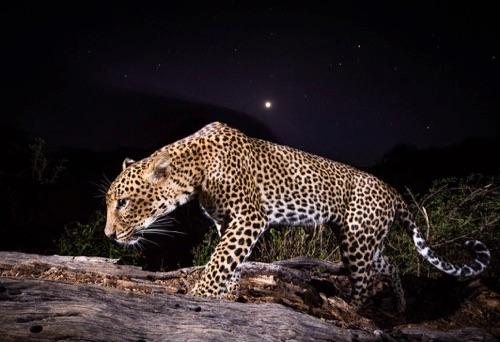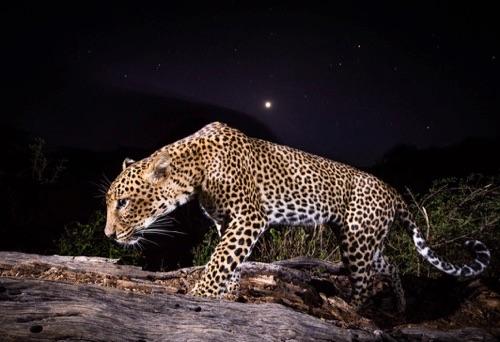
Credit: John Armstrong
The elusive behavior of the African leopard has been revealed in great detail for the first time as part of a sophisticated study that links the majestic cat's caloric demands and its drive to kill.
A team led by Chris Wilmers, associate professor of environmental studies at the University of California, Santa Cruz, produced an unprecedented picture of this carnivore's predatory and reproductive behaviors by outfitting the cats with high-tech wildlife tracking collars equipped with GPS technology and an accelerometer to measure energy output.
"This is the first time we've had really detailed energetic data from a wild terrestrial mammal over an extended period," said Wilmers, lead author of a new paper, "Energetics-informed Behavioral States Reveal the Drive to Kill in African Leopards," which appears today (June 21, 2017) in the online edition of the journal Ecosphere.
The team gathered data from five animals over two months: one adult male; one adult female with one cub; one adult female without cubs; one yearling male cub; and a young "dispersal-aged" male ready to establish his own territory. "The sample size is small, but we got lucky with the diversity of age and sex," noted Wilmers.
Information gleaned from the collars allowed Wilmers' team to match the leopards' behavior with time and place, enabling them to assess the energetic "costs" of reproductive behavior–dispersal and territorial patrol for males; parenting for females.
The study revealed that for male African leopards, territorial patrol activities account for 26 percent of their daily caloric intake; for females, parenting a one-year old offspring consumes 8 percent of their calories.
"Energetics is the ultimate currency for an animal's survival," said Wilmers. "To survive, an animal needs to balance the calories it's expending with the calories it's taking in. If it wants to reproduce, it has to run an energetic surplus."
Wilmers, a wildlife ecologist who studies animal behavior and its cascading effects on ecosystems, continued: "Based on what the leopards are doing, they run up different energetic budgets, which in turn influence their drive to kill. They might kill more prey, bigger prey, or go after more desirable prey in more dangerous places–closer to humans, for example."
One of the most striking behaviors described in the study was a kill by the adult male leopard. The data document him approaching a small village in a meandering fashion. He attacks and kills a goat inside a pen, then spends five minutes dragging the goat across the river to a spot where vegetation gives him the cover he needs to begin feeding.
"It gives us incredible insight into their behavior to see where they are moving and what they're doing on such a fine time scale," said Wilmers. "This allows us to see these cryptic animals moving through their environment."
Another example details the behavior of the adult female with a yearling cub. She kills an aardwolf (a small insect-eating mammal), feeds a bit, then meanders and rests for a few hours until she kills an impala (a medium-sized antelope that is common prey for African leopards). She feeds briefly, then walks directly back to her cub, guiding it first to the aardwolf and then the impala.
Additionally, Wilmers was able to calculate and then compare the energetics of the mother and her son as they traveled together, concluding that the cub expended 12 percent more energy to travel the same distance.
African leopards are among the most elusive mammals on the planet–more so than African lions or cheetahs. "Their whole strategy is to be elusive," said Wilmers. "People get glimpses of them, but that's all. Looking at this data is like going on a safari for the first time and seeing an animal you've only seen in captivity before."
These fine-grained energetics data open the door to understanding the ecological consequences of the leopard's predatory drive. Knowing the African leopard's energetic needs allows researchers to evaluate where they hunt, what they hunt, and to estimate the level of risk they might be willing to take in pursuit of attractive prey. In combination, these factors have implications for humans and the livestock that often share habitat with African leopards.
The placement of a fence, for example, could have energetic "costs" for leopards if they have to travel farther–expending more energy–to patrol territory, hunt, and provide for their offspring. Those costs would increase their drive to kill. "They might take bigger risks, they might catch larger prey like impala, and that could effect the impala population and what they feed on," said Wilmers, outlining the "cascade" of ecosystem effects that could follow human changes to the landscape.
"To be able to link behavior to energetics to ecological effects is an important conceptual advance," said Wilmers. "Once you understand how that circle works, we can assess how our actions will impact the animals, and how those effects will play out on the ecosystem."
###
Coauthors include Lynne Isbell of UC Davis, and Justin Suraci and Terrie Williams of UC Santa Cruz.
Media Contact
Jennifer McNulty
[email protected]
831-459-4399
@ucsc
Original Source
https://news.ucsc.edu/2017/06/wilmers-leopard.html
############
Story Source: Materials provided by Scienmag





